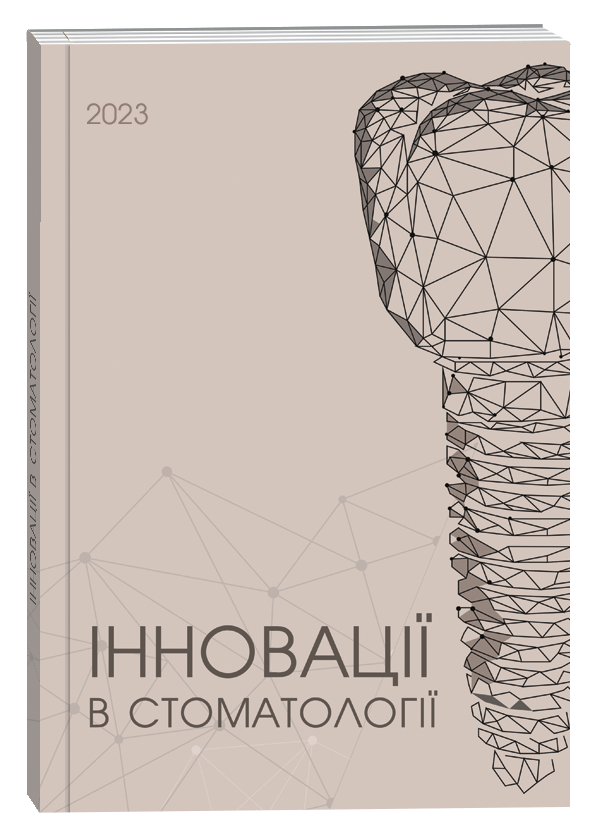АКТУАЛЬНІ ПІДХОДИ ДО ПРИЗНАЧЕННЯ ВІНІРІВ. ПОКАЗАННЯ, ПРОТИПОКАЗАННЯ, РИЗИКИ
DOI:
https://doi.org/10.35220/2523-420X/2025.2.28Ключові слова:
вініри; пародонтит; цукровий діабет; бруксизм; керамічні реставрації; клінічні ризикиАнотація
У сучасній естетичній стоматології керамічні вініри розглядаються як мінімально інвазивна альтернатива традиційним коронкам. Однак успішність таких реставрацій значною мірою залежить від пародонтального статусу, наявності системних захворювань (зокрема цукрового діабету) та парафункціональної активності (бруксизму). Мета дослідження. Узагальнити актуальні показання, протипоказання та ризики, пов’язані з призначенням вінірів у клінічній практиці, на підставі аналізу сучасних наукових джерел. Матеріали та методи. Проведено цільовий огляд 36 публікацій за 2014–2024 рр., відібраних у базах PubMed, Scopus, Web of Science та Google Scholar за ключовими словами “veneers”, “periodontal health”, “diabetes”, “bruxism”, “ceramic restorations”. Оцінку якості виконували за рекомендаціями PRISMA; дані систематизовано описово за тематичними блоками.Результати дослідження. У пацієнтів із цукровим діабетом повні вінірівані коронки спричиняють достовірне підвищення ясеневого індексу та глибинипародонтальних кишень порівняно з контролем без діабету. У хворих на пародонтит III/IV стадії довгострокова (8–13 років) виживаність вінірів не відрізняється від показників у пародонтально здорових осіб за умови стабілізації запального процесу. Бруксизм значно збільшує ризик відколів кераміки; оптимальними вважають комбінацію монолітних цирконієвих коронок для оклюзійної стабілізації з літій-дисилікатними вінірами. Матеріалознавчі дослідження підтверджують переваги літій-дисилікату та високопрозорого цирконію у пацієнтів із підвищеним оклюзійним навантаженням. Висновки. Призначення вінірів потребує комплексної оцінки пародонтального статусу, рівня компенсації цукрового діабету та наявності бруксизму. Дотримання обґрунтованих показань і вибір високоміцних матеріалів мінімізують ускладнення та забезпечують довговічність реставрацій.
Посилання
Yeasmin, L., Rahman, M. M., Banik, R. K., & Islam, A. M. (2022). Effect of full veneer crown on periodontal health in diabetic and non-diabetic patients. Mymensingh Medical Journal, 31(4), 1005–1012.
Salma, M. U., Islam, M. S., Rahman, M. M., & Hossain, M. S. (2023). Impact of full veneer crown restoration on the periodontal health of posterior teeth. Journal of Bangladesh College of Physicians and Surgeons, 41(1), 46–52. https://doi.org/10.3329/jbcps.v41i1.63259
Al-Sinaidi, A., & Preethanath, R. S. (2014). The effect of fixed partial dentures on periodontal status of abutment teeth. Saudi Journal of Dental Research, 5(2), 104–108. https://doi.org/10.1016/j.ksujds.2013.11.001
Liu, S., Yan, H., & Gao, Y. (2020). Effectiveness of porcelain veneer on dental restoration in rats with periodontitis. Indian Journal of Pharmaceutical Sciences, 82, 92–96. https://doi.org/10.36468/pharmaceutical-sciences.spl.130
Tonetti, M. S., Chapple, I. L., & Jepsen, S. (2015). Primary and secondary prevention of periodontal and periimplant diseases: Introduction to, and objectives of, the 11th European Workshop on Periodontology consensus conference. Journal of Clinical Periodontology, 42(Suppl. 16), 1–4. https://doi.org/10.1111/jcpe.12382
Zhang, W., Ju, J., Rigney, T., & Tribble, G. (2014). Porphyromonas gingivalis infection increases osteoclastic bone resorption and osteoblastic bone formation in a periodontitis mouse model. BMC Oral Health, 14, 89. https://doi.org/10.1186/1472-6831-14-89
Gaß, J. A., Kwon, T., Romanos, G. E., et al. (2023). Ceramic anterior veneer restorations in periodontally compromised patients: A retrospective study. Clinical Advances in Periodontics, 13(4), 266–275. https://doi.org/10.1002/cap.10246
Simeone, P., Leofreddi, G., & Kois, J. C. (2016). Managing severe periodontal esthetic challenges: The restorative-surgical connection. International Journal of Periodontics & Restorative Dentistry, 36(1), 83–93. https://doi.org/10.11607/prd.2618
Chen, M. X., Lu, R. F., Shi, D., et al. (2021). Global, regional, and national burden of severe periodontitis, 1990–2019: An analysis of the Global Burden of Disease Study 2019. Journal of Clinical Periodontology, 48(9), 1165–1188. https://doi.org/10.1111/jcpe.13506
El Sayed, N., Baeumer, A., El Sayed, S., et al. (2019). Twenty years later: Oral health-related quality of life and standard of treatment in patients with chronic periodontitis. Journal of Periodontology, 90(4), 323–330. https://doi.org/10.1002/JPER.18-0417
Yap, A. U., & Chua, A. P. (2016). Sleep bruxism: Current knowledge and contemporary management. Journal of Conservative Dentistry, 19(5), 383–389. https://doi.org/10.4103/0972-0707.190007
Mengatto, C. M., Coelho-de-Souza, F. H., & de Souza, O. B. (2016). Sleep bruxism: Challenges and restorative solutions. Clinical, Cosmetic and Investigational Dentistry, 8, 71–77. https://doi.org/10.2147/CCIDE.S70715
Lobbezoo, F., Ahlberg, J., Raphael, K. G., et al. (2018). International consensus on the assessment of bruxism: Report of a work in progress. Journal of Oral Rehabilitation, 45(11), 837–844. https://doi.org/10.1111/joor.12663
de Souza Melo, G., Araujo, C., Corrêa, I., et al. (2018). Association of sleep bruxism with ceramic restoration failure: A systematic review and meta-analysis. Journal of Prosthetic Dentistry, 119(3), 354–362. https://doi.org/10.1016/j.prosdent.2017.07.005
Cervino, G., Minervini, G., Chaturvedi, S., et al. (2023). Influence of temporomandibular disorders and bruxism on prosthodontic rehabilitation survival: A focus on veneers. In IFMBE Proceedings – MEDICON’23 and CMBEBIH’23 (Vol. 94, pp. 695–701). Springer Nature Switzerland. https://doi.org/10.1007/978-3-031-49068-2_71
Raphael, K. G., Santiago, V., & Lobbezoo, F. (2016). Is bruxism a disorder or a behavior? Rethinking the international consensus on defining and grading of bruxism. Journal of Oral Rehabilitation, 43, 791–798. https://doi.org/10.1111/joor.12413
Manfredini, D., De Laat, A., Winocur, E., & Ahlberg, J. (2016). Why not stop looking at bruxism as a black/white condition? Aetiology could be unrelated to clinical consequences. Journal of Oral Rehabilitation, 43, 799–801. https://doi.org/10.1111/joor.12426
Raphael, K. G., Santiago, V., & Lobbezoo, F. (2016). Bruxism is a continuously distributed behaviour, but disorder decisions are dichotomous. Journal of Oral Rehabilitation, 43, 802–803. https://doi.org/10.1111/joor.12425
Svensson, P., Lavigne, G. J., & Gagnon, Y. (2016). Sleep bruxism: Definition, prevalence, classification, etiology and consequences. In M. H. Kryger, T. Roth, & W. C. Dement (Eds.), Principles and practice of sleep medicine (6th ed., pp. 1423–1426). Elsevier.
Saito, M., Yamaguchi, T., Mikami, S., et al. (2016). Weak association between sleep bruxism and obstructive sleep apnea: A sleep laboratory study. Sleep and Breathing, 20, 703–709. https://doi.org/10.1007/s11325-015-1284-x
Lobbezoo, F., Ahlberg, J., Raphael, K. G., et al. (2016). Sleep bruxism: Diagnostic considerations. In M. H. Kryger, T. Roth, & W. C. Dement (Eds.), Principles and practice of sleep medicine (6th ed., pp. 1427–1434). Elsevier.
Yachida, W., Arima, T., Castrillon, E. E., et al. (2016). Diagnostic validity of self-reported measures of sleep bruxism using an ambulatory single-channel EMG device. Journal of Prosthodontic Research, 60, 250–257. https://doi.org/10.1016/j.jpor.2016.01.001
Wetselaar, P., & Lobbezoo, F. (2016). The tooth wear evaluation system (TWES): A modular clinical guideline for the diagnosis and management planning of worn dentitions. Journal of Oral Rehabilitation, 43, 69–80. https://doi.org/10.1111/joor.12340
Yoshida, Y., Takeshima, T., Kato, T., et al. (2017). Association between patterns of jaw motor activity during sleep and clinical signs and symptoms of sleep bruxism. Journal of Sleep Research, 26, 415–421. https://doi. org/10.1111/jsr.12481
Muzalev, K., Lobbezoo, F., Janal, M. N., & Raphael, K. G. (2017). Inter-episode sleep bruxism intervals and myofascial face pain. Sleep, 40, zsx078. https://doi.org/10.1093/sleep/zsx078
Levartovsky, S., Aviv, I., Aharoni, C., et al. (2019). Complete rehabilitation of patients with bruxism by veneered and non-veneered zirconia restorations with an increased vertical dimension of occlusion: An observational case-series study. Journal of Prosthodontic Research, 63, 440–446. https://doi.org/10.1016/j.jpor.2019.02.006
Ahci, S., Bal, B., Benbir-Senel, G., et al. (2022). Polysomnographic characteristics of sleep-related bruxism: What are the determinant factors for temporomandibular disorders? Cranio: The Journal of Craniomandibular & Sleep Practice, 40, 544–550. https://doi.org/10.1080/08869634.2021.2014167
Moreira, A., Freitas, F., Marques, D., & Caramês, J. (2019). Aesthetic rehabilitation of a patient with bruxism using ceramic veneers and overlays combined with four-point monolithic zirconia crowns for occlusal stabilization: A 4-year follow-up. Case Reports in Dentistry, 2019, 1640563. https://doi.org/10.1155/2019/1640563
Moreira, A., Freitas, F., Marques, D., & Caramês, J. (2019). Aesthetic rehabilitation of a patient with bruxism using ceramic veneers and overlays combined with four-point monolithic zirconia crowns for occlusal stabilization: A 4-year follow-up. Case Reports in Dentistry, 2019, 63–70. https://doi.org/10.1155/2019/1640563
Abdulmajeed, A. A., Lim, K. G., Närhi, T. O., & Cooper, L. F. (2016). Complete-arch implant-supported monolithic zirconia fixed dental prostheses: A systematic review. Journal of Prosthetic Dentistry, 115(6), 672–677.e1. https://doi.org/10.1016/j.prosdent.2015.08.025
Rashid, H., Sheikh, Z., Misbahuddin, S., et al. (2016). Advancements in all-ceramics for dental restorations and their effect on the wear of opposing dentition. European Journal of Dentistry, 10(4), 583–588. https://doi.org/10.4103/1305-7456.195170
Mesko, M. E., Cho, S. H., Rupf, S., et al. (2016). Rehabilitation of severely worn teeth: A systematic review. Journal of Dentistry, 48, 9–15. https://doi.org/10.1016/j.jdent.2016.03.003
Hansen, T. L., van Dijken, J. W. V., Hede, K. C., et al. (2018). Monolithic zirconia crowns in the aesthetic zone in heavy grinders with severe tooth wear: An observational case-series. Journal of Dentistry, 72, 14–20. https://doi. org/10.1016/j.jdent.2018.03.003
Konstantinidis, I., Papalexopoulos, A., Andreadis, G., et al. (2018). Clinical outcomes of monolithic zirconia crowns with CAD/CAM technology: A 1-year prospective clinical study of 65 patients. International Journal of Environmental Research and Public Health, 15(11), 2553. https://doi.org/10.3390/ijerph15112553
Floriani, F., Coelho, N. F., Linhares, L. A., et al. (2024). Semidirect resin composite veneers in a patient with bruxism. Case Reports in Dentistry, 2024, 5572481. https://doi.org/10.1155/2024/5572481
Sperber, G. H. (2017). Dental wear: Attrition, erosion, and abrasion – a palaeo-odontological approach. Dentistry Journal, 5(2), 19–27. https://doi.org/10.3390/dj5020019
##submission.downloads##
Опубліковано
Як цитувати
Номер
Розділ
Ліцензія

Ця робота ліцензується відповідно до Creative Commons Attribution 4.0 International License.







